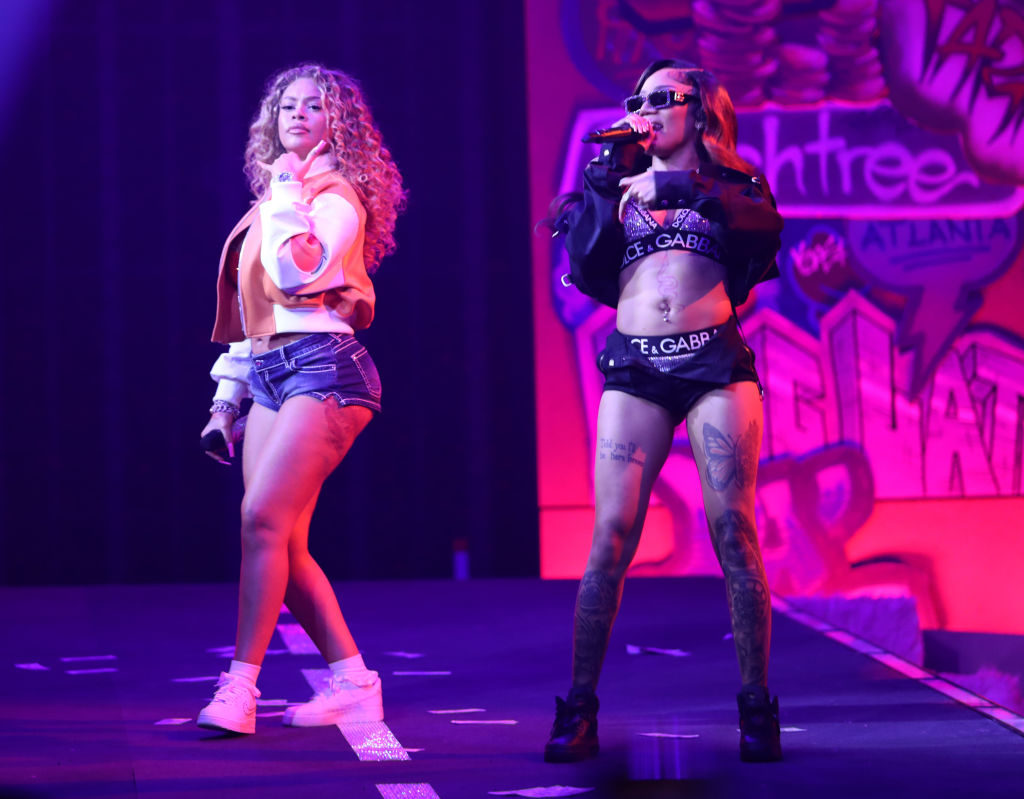Source: Jerritt Clark / Getty
For decades, the official “Women in Hip-Hop” discussion focused on the scarcity of female MCs with record deals. As the story went, (straight) men didn’t want to hear women rap; at best, they wanted to f*ck them.
The added cost of their makeup and hair was a popular cop-out. And despite valiant displays of unity, such as Lil’ Kim’s “Not Tonight” video, the industry insisted that there was only room for one queen at a time.
But over the last four years or so, the emergence of a post-Nicki Minaj bumper crop of “rap girlies” has shifted the conversation. This class of young, fun, profane and pretty-in-the-face MCs includes Brooklyn’s Lola Brooke, Atlanta’s Latto, Memphis’ GloRilla and Hackensack, New Jersey’s, Coi Leray.
Their aesthetic fairy godmothers are Lil’ Kim, Foxy Brown and Trina. Their best-selling big sister Nicki Minaj showed them how to fuse raw sex appeal and a pop sensibility with undeniable lyricism. Favorite cousins Cardi B and Megan Thee Stallion taught them the value of sisterhood.
As a Gen Xer who is almost as old as the maybe-official birthdate of Hip-Hop, I’m happy to see so many female rappers becoming stars. But I’m also conflicted about what they’re selling.
I’m all for girls getting the bag, but I’m concerned about the materialism that sometimes stands in for self-worth. I dig p*ssy-power anthems like “WAP,” but I’m doing so under the specter of white supremacist stereotypes of Black sexuality. I’m interested in the queering of Hip-Hop by artists like Young M.A, but I’m bored by the nameless femmes they visually deploy to compete with men.
So far, I’m not that auntie who once dropped it low to “My Neck, My Back” but now blames Sexyy Red for everything wrong in the culture. But I refuse to pretend that misogynoir in Hip-Hop no longer matters.
If it didn’t, Megan Thee Stallion wouldn’t have endured years of low blows and harassment for being shot by a balding Canadian sadist. Oprah Winfrey wouldn’t have withdrawn her support of Off the Record, the HBO documentary about some of the women who Russell Simmons allegedly raped. Serial abuser Dr. Dre wouldn’t have a new Global Impact Grammy in his name. And people wouldn’t be more upset by the idea of Sean Combs having sex with men than allegedly raping, trafficking and beating women.
Despite the stubborn misogyny of Hip-Hop—and American culture in general—more female rappers have been able to break through thanks in part to visual platforms like TikTok and Instagram.
“We are living in an era, a time, a moment where, I don’t believe we’ve had so many women rappers simultaneously having success at the same time,” said Ebro Darden on Rap Life Review last March. “I don’t know if there’s been this many ever, and I think that’s phenomenal.”
Sexually explicit lyrics have been acceptable for decades, but girliness has been taboo. That’s why it was so wicked of Lil’ Kim to hop on Mobb Deep’s “Quiet Storm” remix and accuse her rival, Foxy Brown, of “comin’ in the game on some modeling shit.” Today, being model-pretty, hyper-femme and slim in the waist is damn near a prerequisite for making a hit song.
To better follow the current crop, I’ve been watching video mixes curated by a Chicago DJ named 3 Snapz. Since 2021, her Queens series has served as a compendium of bad-b*tch rap from around the country. For instance, the 2024 edition features mainstays like Meg and Cardi, pop stars like Doja Cat and Ice Spice, and a thrilling contingent of Big Apple bullies — Scarlip, Armani Ceasar, and Connie Diiamond with Remy Ma
But with a few exceptions, like Flyana Boss and the U.K.’s Cristale and Teezandos, the visuals draw from a finite set of cliches: The girlies are smacking a*s in the strip club! They’re twerking in the parking lot with their friends! They’re hanging out of luxury car windows in bikini tops! They’re bossing up in leather, fur and lingerie!
The irony of this NC-17-to-XXX fever dreamscape is that most of these women are decent rappers. They might not have the gravitas of a Ms. Lauryn Hill or the lyrical dexterity of Nicki Minaj, but they know how to ride a beat, talk their shit and make solid records. And they aren’t doing it to prove anything to men. They’re competing with one another. Latto illustrates this ethos in “Sunday Service.”
“These bitches corny, soon as monkey see, then you know monkey do/ Do you rap or do you tweet?/ ‘Cause I can’t tell, get in the booth, b*tch.”
In the video, she punctuates the line with a “Get in the booth b*tch” T-shirt.
To be sure, there have always been women MCs whose beauty, flyness and sex appeal are as important as their music. (Think Salt-N-Pepa, Eve and Trina.) But as Rapsody pointed out in her excellent Tiny Desk Concert, there used to be more variation among the top acts.
“I try to do something different because nowadays you see one particular image of us [as] sexy. Everything is real sexed up,” the self-proclaimed “girl next door” said. “Like I grew up on Lauryn Hill, MC Lyte, Queen Latifah, Missy Elliott, Jean Grae; all of them were different. They had different styles and showed you all sides of what sexy and beautiful is as a woman.”
On a 2022 episode of Caresha Please — an artifact of face-card Hip-Hop culture—Saweetie illustrated the limitations of prettiness as a brand.
“I feel like I blew up too quick, to the point where I was being booked for shows, for campaigns, for brands, and no one really cared about me going to the studio,” the Bay Area native said. “My love for music just got put on the back side.”
In an industry where it can be easier for artists to make more money doing brand partnerships, haircare lines and beauty ads than they do selling music, Saweetie’s commitment to getting in the studio is significant. Rappers like her stand on the shoulders of pioneers like MC Sha-Rock, friendly rivals like Roxanne Shante and Sparky D., and late-’80s glamor girls like Oaktown’s 3.5.7 and J.J. Fad. And then there are the more obvious lineages: La Chat and the late great Gangsta Boo birthed GloRilla, Latto and JT. Missy Eliott begot Tierra Whack, Leikeli47 and Flyana Boss. Ms. Lauryn Hill created a lane for Akua Naru, Sa Rock and Mumu Fresh. Queen Latifah and MC Lyte wrote the blueprint for Rapsody, Noname, Chika and Flau’Jae.
Superstar Megan Thee Stallion continues to expand what it means for a female rapper to be the total package. Yes, she is known for her body, twerk proficiency and raunchy lyrics. But she also fought her way out of an exploitative 360 record deal, linking a “groundbreaking” agreement with Universal Records that will allow her to own her masters and publishing while benefiting from the label’s distribution system.
And while so many of the current crop of female rap stars are proud to be pretty in the face, I like how grounded they are. As Brooklyn’s Lady London purrs on the remix of Ciara’s “Da Girls”:
“This is for the girls on the grind/This is for the girl that’ll work full-time./ This is for the self-made girls, yeah, the self-paid girls/ Better never let ’em change your mind./ Girls who fly, girls who thrive, livin’ out dreams that money just can’t buy.”
Akiba Solomon is an NABJ Award-winning writer and editor from West Philadelphia. The Howard University graduate has written about Hip-Hop culture and politics for The Source, XXL, Vibe, Vibe Vixen, Essence and Colorlines. Solomon is the co-author of two books: “Naked: Black Women Bare All About Their Skin, Hair, Hips, Lips, and Other Parts” and “How We Fight White Supremacy: A Field Guide to Black Resistance.”




